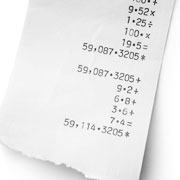
How to make/fill out your own personal budget worksheet
For many, the word “budget” has little meaning before entering college. For high school students, budgeting isn’t usually a big part of day-to-day events, however entering the “real world,” that notion of financial freedom has changed and budgeting has become a way of life. Now, every penny earned needs to be planned, while each bill is scrutinized for any inconsistencies. A budget is nothing more than a breakdown and plan of how much money you have coming in and where it goes. Here’s our advice for creating a personal budget worksheet to manage your cash.
Entering college is an expensive venture, “scholarships and grants are an excellent source of money to pay for college,” said Lynn O’Shaughnessy, author of “The College Solution,” an Amazon bestseller, and consulting director of college planning, K-12 Program, UCSD Academic Connections.
In some circumstances, students are eligible for grants or personal scholarships. However, both financial avenues are specific and require a great deal of research and preparation. It is difficult enough balancing a class schedule, on top of a part-time job, so the thought of managing a budget can cause panic for even the most meticulous mathematician.
However, creating a personal budget worksheet breaking down what you spend vs. what you earn, can help you stay out of debt and away from accumulating a collection of credit cards.
At Financialfootprint.com, there are financial tools and secrets to help create a practical and manageable personal budget worksheet for every type of lifestyle. Inputting your information into financialfootprint.com’s budgeting worksheet, the budget, can be as simple as you want or as comprehensive as you need. Financialfootprint.com leaves creating the budget up to you; it takes your data and organizes it into categories that make sense based on your lifestyle.
“Private and state colleges and universities build their financial aid packages by starting with federal student aid. Parents hope they will receive federal financial aid, but for many families, the only federal aid they will receive is loans,” said O’Shaughnessy.
The budget also studies monthly and yearly perspectives, so you have both a short and long-term plan. Both play a significant role in how you should plan for college and for the future. By creating (or filling out) a personal budget worksheet, you are creating a financial plan that breaks down what you earn vs. what you spend. This also shows areas where a person can cut back or eliminate all together. These are important areas; they show where your money is going and how to save instead of spending it. A budget has the potential to change overnight—so the plan will need to be updated regularly.
Everything from textbooks, groceries, transportation, school supplies and entertainment, will need to be noted. It will cost money; there’s no getting around it. Fortunately, budget planning can help you “make the most out of a dollar.”
According to financial experts, there is an increase in ignorance among college students about one of the biggest risks they will undertake, debt. They are unaware of the impact their current choices on their future and how maintaining a budget can help them reduce their debt.
A budget spreadsheet lists everything you spend money on, from daily life to monthly expenses. Now, creating it or filling it out is the easy part, the hard part is sticking to it. Don’t be swayed by promises of “spend now, pay back later,” because you accumulate unnecessary interest on those purchases. This also impacts your credit and also plays a factor in future investments.















